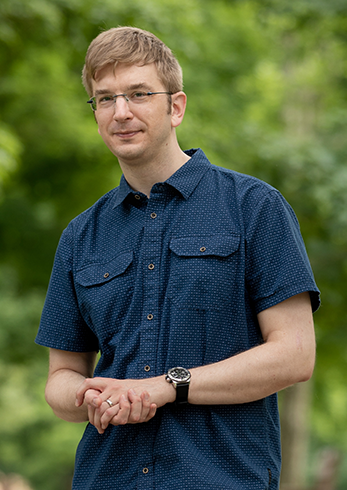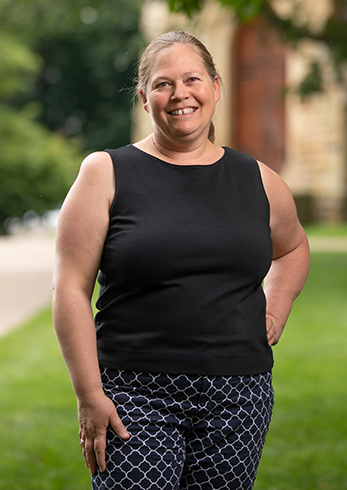Eighty Years On
As the Kenyon Review celebrates a milestone birthday, the Bulletin explores how the storied journal became a leading…
Read The StoryEvery spring, Kenyon honors two standout faculty members with the Trustee Teaching Excellence Award. This year’s recipients were James H. McGavran III ’02, assistant professor of Russian, as a junior professor; and Karen Hicks, associate professor of biology, as a senior faculty member.
Every spring, Kenyon honors two standout faculty members with the Trustee Teaching Excellence Award. This year’s recipients were James H. McGavran III ’02, assistant professor of Russian, as a junior professor; and Karen Hicks, associate professor of biology, as a senior faculty member.
After graduating from Kenyon in 2002 and earning a master of arts and doctorate from Princeton University, McGavran joined Kenyon’s faculty in 2010. McGavran teaches Russian language and literature courses, and his research interests include 20th-century Russian poetry and poetics, poetic translation, Soviet-era prose and theories of the comic. In a nomination, one student wrote that McGavran is “unendingly excited about Russian language, culture and literature,” inspiring students to share the same passion.
Hicks, who came to Kenyon in 1999, teaches courses in genetics and developmental biology as well as introductory lecture and lab classes. Her research focuses on how plants sense seasonal cues and whether that sense is ancient and evolved before flowering plants and moss diverged 500 million years ago.
Hicks earned her bachelor of science at Swarthmore College and her doctorate at the Massachusetts Institute of Technology. Hicks and her science colleagues have received a number of key research grants in recent years, and she’s helped lead the department’s diversity and inclusion initiatives.
In nominating Hicks, colleagues praised her for “transforming educational practice for many of us across the [natural sciences] division” and her “firm belief that each of your students has the ability to excel in science.” Students noted that Hicks “puts responsibility on students to take their experience into their own hands” and encourages them to “become the best scientists and people that they can be.”

Where does your passion for Russian history and culture originate?
I came to Kenyon as an undergraduate wanting to learn Russian because of my interests in chess and Russian piano composers (Rachmaninoff and Scriabin). During my time as a student here, my love of Russian literature and culture was fostered by my faculty advisor and mentor, Professor Natalia Olshanskaya. It was her survey of Russian literature in translation that first introduced me to many of the authors and texts I grapple with to this day, and her combination of high intellectual standards with boundless personal warmth, fierce advocacy and hospitality exemplifies what I consider to be the very best of Russian cultural traditions.
You teach a class on Russian poetry. Who are some of your favorite poets, past and present?
Pushkin is remarkable in his breadth and universality; he both established and revolutionized nearly every genre in Russian literature. I am in awe of Marina Tsvetaeva’s linguistic brilliance and formal innovations, and I am often moved to tears by the relentless emotional intensity of her engagement with literary tradition, from classical mythology and Russian folklore to Rainer Maria Rilke. Osip Mandelstam, with his Acmeist “longing for world culture,” created a densely allusive and symbolically rich poetics in nwhich every line seems to buzz and crackle with meaning like a live electrical wire. Among contemporary poets, I feel fortunate to have met Elena Shvarts (1948–2010) and talked with her about my translations of her work, and I am currently collaborating with Alexander Skidan (b. 1965) on more new translations.
Russia has become a topic of near-constant attention/discussion in our current 24-hour news cycle. What impact, if any, does this have on your work? Are more students lining up to learn the language?
Russia’s ubiquity in the news so far hasn’t directly impacted my work or Kenyon’s Russian enrollments, nor is the “know your enemy” ethos from the Cold War something I particularly want to revive. I am of course dismayed by Russia’s return to an authoritarian and increasingly nationalistic government that shows little regard for human or civil rights, and I am alarmed by that government’s concerted, ongoing efforts to undermine and destabilize Western democracies.
What is the biggest lesson you have learned from teaching?
My personal ethics are based above all on the uniqueness and unrepeatability of every living creature, and my students and coworkers at Kenyon serve as a daily reminder of that uniqueness. They teach me a great deal about the variety of human experience, ingenuity and resilience.

You serve as principal investigator for a National Science Foundation grant that awards scholarships to low income, academically talented students at Kenyon, supporting them with high-impact practices to increase their persistence and graduation. Why is inclusion in STEM a priority for you?
Any student who’s excited by sciences should be able to be successful here, but at Kenyon and nationwide, there’s a relatively low persistence rate in STEM fields. And persistence is lower for students in minoritized populations, as well as for female students in certain disciplines. That’s likely due to institutional biases. We’re working on changing the institution and providing programs to help alleviate this.
I think that all kids, when they’re young, are really excited by science. I don’t know how great our education system is at keeping that alive, and we are constantly assuming that scientists fit only one kind of mold. My daughter’s first grade class was asked to draw a picture of a scientist. Do you know what all the pictures looked like? All white men, wearing glasses, in lab coats. Except for my daughter’s. There’s an underlying bias. Research, however, shows that diverse groups of people solve problems more effectively than homogenous groups.
What is the biggest lesson you have learned from teaching?
I wasn’t taught how to teach in graduate school, so, in the beginning, I didn’t really know what I was doing. I just did my best and I tried to do what other people had done, and what made sense to me. The field of research on pedagogy has grown over the past decade, and there’s an increase in awareness of this field here at Kenyon. Approaching teaching more scientifically has been useful to me. I’ve figured out lately that approaching the classroom in the same way that I approach my science research — trying new things and then evaluating what happens — works for me.
Can you share an example of this approach?
I give each student in my class a playing card and then I keep a matched deck in my pocket. I shuffle the cards and then draw one. And the student with the matching card gets to talk. Research shows that calling on students randomly equalizes contributions in the classroom across genders, and I suspect the same is true across racial ethnic lines, as well. I share this body of research with my students. I’m trying to be transparent with them about my methods and why I’m doing things this way. Which is, again, what a scientist does. We’re always transparent about our methods.
As the Kenyon Review celebrates a milestone birthday, the Bulletin explores how the storied journal became a leading…
Read The StoryThese students are living their dreams and claiming their places in the workforce.
Read The StoryWhat will it take to boost socioeconomic diversity at Kenyon? And why does it matter?
Read The Story